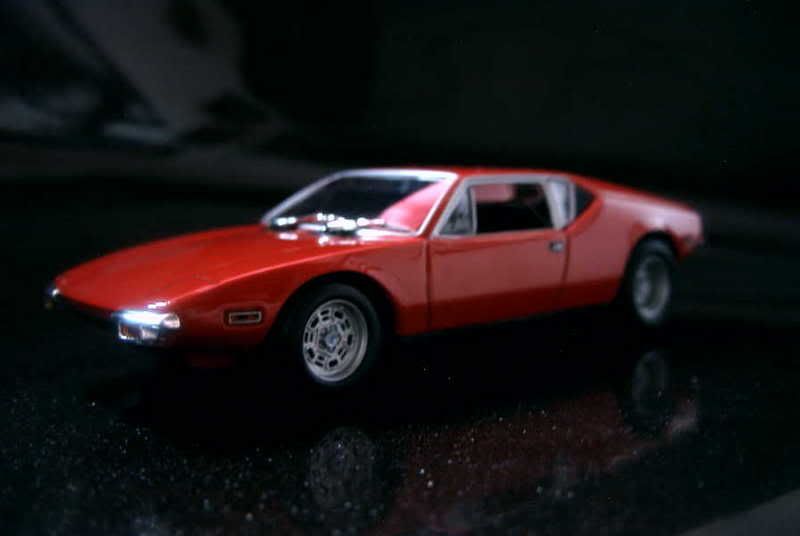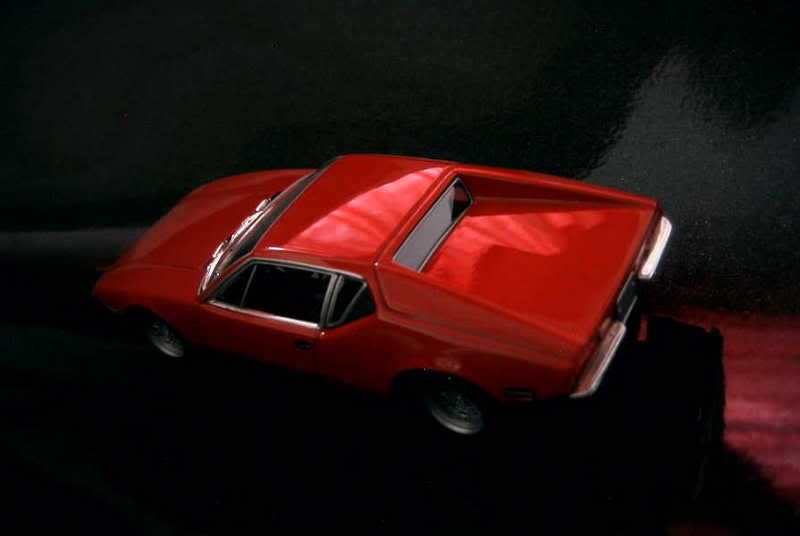A little history
The Pantera is the symbiosis of both the best and worst De Tomaso had to offer. When the car was released in 1970, the company was at an all-time high. Its previous model, the Mangusta, had been highly praised; the little firm was involved in Formula One; and traditional partner Ford had decided to distribute the new De Tomaso through its network in the U.S. What went wrong then?
Though not as striking as the Mangusta’s, the Pantera’s body, designed by Tom Tjaarda at Ghia, was certainly glamorous and immediately placed the new sportscar in the same category as the Ferraris, Maseratis or Lamborghinis. A mid-engine machine, the Pantera was powered by a more plebeian engine than some of its direct rivals, namely by Ford’s 5.8-litre V8 “Cleveland”, a block which on the other hand provided hopes for reliability, without impairing performance. The gearbox was provided by ZF. This use of widely built mechanical components also allowed the Pantera to be much better priced than its competitors. Alas, the fatal blow came from construction quality. Placed in the hands of the demanding American customers, built in such large quantities De Tomaso could only dream of two years before, poorly-built Panteras almost literally disintegrated, and furthermore rusted away at an incredible pace. As a consequence, Ford lost interest in its relationship with the small Italian company. In 1973, the year of the infamous oil crisis, the American giant denounced its agreement – De Tomaso was on its own.
It is probable that during the same period Alejandro de Tomaso, the company’s founder, had overestimated the capacities of its small concern. Rather optimistically, he had purchased Vignale, then Ghia. De Tomaso also extended its activities to two-wheel transportation, gained a controlling interest in both Benelli and Moto Guzzi at a time when the Italian motorcycle industry wasn’t at its best. Furthermore, De Tomaso purchased both carmakers Innocenti and Maserati. The latter was undoubtedly an operation that boosted De Tomaso’s pride as Maserati had been a fierce rival, but did nothing to improve the company’s finances.
During the following years, most of the elements of this small industrial empire had to be sold one by one to keep De Tomaso afloat. None of the two design studios proved profitable and, while Vignale was simply closed in 1974, Ghia was sold to Ford, which made good use of its famous name. Desperately ageing, the Pantera, by then built entirely by hand and sold in so small quantities that some even doubted it was still in production, finally retired in 1991. The Guarà replaced it, but by then De Tomaso had definitely lost touch with the highly competitive sportscar market, and production remained confidential. Both Maserati and Innocenti were sold to Fiat in 1993, and De Tomaso quietly and inexorably headed towards bankruptcy, which happened in 2004. Though apparently the company has not yet been liquidated, a close inspection at its internet site (http://www.detomaso.it) reveals that the latter has not been updated for the last seven years now – the Guarà is still described as being in production, though actually discontinued for a long time now. As luck would have it, you can even apply for a job online with a company that sadly only exists on paper…
About the model
Model: De Tomaso Pantera
Year: 1972
Maker: Minichamps
Scale: 1/43
Distributed by: Minichamps, limited edition - 5,520 pieces
Acquired: brand new, in September 2007, in Manila, Philippines
Minichamps reproduced here a Pantera from De Tomaso’s sunny days, still immaculate in the original dress Djaarda designed for it. The German maker’s usual quality throughout: 14/20.


The Pantera is the symbiosis of both the best and worst De Tomaso had to offer. When the car was released in 1970, the company was at an all-time high. Its previous model, the Mangusta, had been highly praised; the little firm was involved in Formula One; and traditional partner Ford had decided to distribute the new De Tomaso through its network in the U.S. What went wrong then?
Though not as striking as the Mangusta’s, the Pantera’s body, designed by Tom Tjaarda at Ghia, was certainly glamorous and immediately placed the new sportscar in the same category as the Ferraris, Maseratis or Lamborghinis. A mid-engine machine, the Pantera was powered by a more plebeian engine than some of its direct rivals, namely by Ford’s 5.8-litre V8 “Cleveland”, a block which on the other hand provided hopes for reliability, without impairing performance. The gearbox was provided by ZF. This use of widely built mechanical components also allowed the Pantera to be much better priced than its competitors. Alas, the fatal blow came from construction quality. Placed in the hands of the demanding American customers, built in such large quantities De Tomaso could only dream of two years before, poorly-built Panteras almost literally disintegrated, and furthermore rusted away at an incredible pace. As a consequence, Ford lost interest in its relationship with the small Italian company. In 1973, the year of the infamous oil crisis, the American giant denounced its agreement – De Tomaso was on its own.
It is probable that during the same period Alejandro de Tomaso, the company’s founder, had overestimated the capacities of its small concern. Rather optimistically, he had purchased Vignale, then Ghia. De Tomaso also extended its activities to two-wheel transportation, gained a controlling interest in both Benelli and Moto Guzzi at a time when the Italian motorcycle industry wasn’t at its best. Furthermore, De Tomaso purchased both carmakers Innocenti and Maserati. The latter was undoubtedly an operation that boosted De Tomaso’s pride as Maserati had been a fierce rival, but did nothing to improve the company’s finances.
During the following years, most of the elements of this small industrial empire had to be sold one by one to keep De Tomaso afloat. None of the two design studios proved profitable and, while Vignale was simply closed in 1974, Ghia was sold to Ford, which made good use of its famous name. Desperately ageing, the Pantera, by then built entirely by hand and sold in so small quantities that some even doubted it was still in production, finally retired in 1991. The Guarà replaced it, but by then De Tomaso had definitely lost touch with the highly competitive sportscar market, and production remained confidential. Both Maserati and Innocenti were sold to Fiat in 1993, and De Tomaso quietly and inexorably headed towards bankruptcy, which happened in 2004. Though apparently the company has not yet been liquidated, a close inspection at its internet site (http://www.detomaso.it) reveals that the latter has not been updated for the last seven years now – the Guarà is still described as being in production, though actually discontinued for a long time now. As luck would have it, you can even apply for a job online with a company that sadly only exists on paper…
About the model
Model: De Tomaso Pantera
Year: 1972
Maker: Minichamps
Scale: 1/43
Distributed by: Minichamps, limited edition - 5,520 pieces
Acquired: brand new, in September 2007, in Manila, Philippines
Minichamps reproduced here a Pantera from De Tomaso’s sunny days, still immaculate in the original dress Djaarda designed for it. The German maker’s usual quality throughout: 14/20.





No comments:
Post a Comment